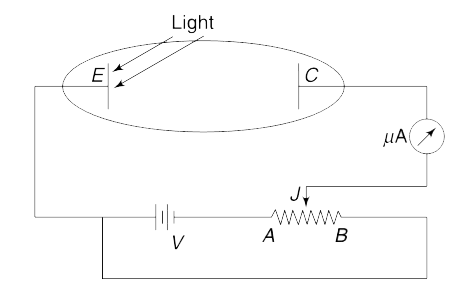In an experiment on photoelectric effect light of wavelength 400nm is incident on a metal plate at rate of 5W. The potential of the collector plate is made sufficiently positive with respect to emitter so that the current reaches the saturation value. Assuming that on the average one out of every 106 photons is able to eject a photoelectron, find the photocurrent in the circuit.
0.4μA
0.8μA
1.2μA
1.6μA
The correct Answer is:D
P=nhcλ
n=Pλhc=5×400×10−96.6×10−34×3×108=1019
Number of electrons ejected / sec =n'=n106=1019106=1013
Saturation current i=n'e=1013×1.6×10−19
=1.6×10−6A=1.6μA
Topper's Solved these Questions
Similar Questions
In an experiment on photoelectric effect light fo wavelength 400 nm is incident on a metal plate at rate of 5W. The potential of the collector plate is made sufficiently positive with respect to emitter so that the current reaches the saturation value. Assuming that on the average one out of every 106 photons is able to eject a photoelectron, find the photocurrent in the cirucuit.
View Solution(a) 1 mW of light of wavelength 456 nm is incident on a cesium surface. Calculate the photoelectric current produced, if the quantum efficiency of the surface for photoelectric emission is only 0.5%.
(b) In an experiment on photoelectric effect, light of wavelength 400 nm is incident on a cesium plate at the rate of 5.0W. The potential of the collector plate is made sufficiently positive with respect to the emitter so that the current reaches its saturation value. Assuming that on the average one out of every 106 photons is able to eject a photoelectron, find the photocurrent in the circuit.
View Solution
Knowledge Check
A silver of radius 4.8cm is suspended by a thread in the vacuum chamber . UV light of wavelength 200nm is incident on the ball for some times during which a total energy of 1×10−7J falls on the surface . Assuming on an average one out of 103 photons incident is able to eject electron. The potential on sphere will be
A1VB2VC3VDZeroIn photoelectric effect light of certain frequency (> threshold frequency ) is incident on a metal surfave whereby , an e− ( with certain K.E.) moves towards the collector plate and a flow of current is initiated . In order to stop the current flow, an opposite potential , on the two metal plates, is applied
A light of frequency 2.5×1015Hz is incident on a metal surface having work function 4 eV. The velocity of photoelectron is ( in cm s−1)A1.5×106B1.5×108C2×108D2.5×104In photoelectric effect light of certain frequency (> threshold frequency ) is incident on a metal surfave whereby , an e− ( with certain K.E.) moves towards the collector plate and a flow of current is initiated . In order to stop the current flow, an opposite potential , on the two metal plates, is applied
The work function of metal is 6eV . If light of frequency 1×1015Hz is incident on the metal , intensity of light is increased 4 times, thenANo photoelectron will be ejectedB8 photoelectrons of zero kinetic energy shall be ejectedC2 photoelectrons of 2 eV kinetic energy are ejectedDOnly one photoelectron is ejected
In an experiment on photoelctric effect, light of wavelength 800nm ( less than threshold wavelength) is incident on a cessium plate at the rate of 5.0W. The potential of the collector plate is made sufficiently positive with respect to the emitter so that the current reaches its saturation value. Assuming that on the average one of every 106 photons is able to eject a photoelectron, find photo current in the circuit.
View SolutionA silver ball of radius 4.8 cn is suspended by a thread in a cacuum chamber, Ultraviolet light of wavelength 200nm is incident on the ball for some time during which a total light energy of 1.0×(10−7) J falls on the surface. Assuming that on the average one photon out of every ten thousand is able to eject a photoelectron, find the electric potential at the surface of the ball assuming zero potential at infinity. What is the potential at the centre of the ball?
View SolutionIn the figure shown, electromagnetic radiations of wavelength 200nm are incident on the metallịc plate A. The photoelectrons are accelerated by a potential difference of 10V. These electrons strike another metal plate B from which electromagnetic radiations are emitted. The minimum wavelength of the emitted photons is 100nm. Find the work function of the metal A (in eV). (Use hc=12400eVAo,Rch=13.6eV)
'(##CEN_KSR_PHY_JEE_CO28_E01_022_Q02##)' FIGURE
View SolutionIn a photoelectric experimental set-up ultraviolet light of wavelength 350 nm is incident on emitter plate (E). The work function of the emitter plate is ϕ=2.2 eV. AB is a uniform wire resistor having length L=100cm. Resistance of the wire AB is 10 W and the emf of the battery is V=10 volt. The sliding contact J can be moved along the wire AB. When the sliding contact is placed at end B of the wire resistor the micro-ammeter shows a reading of i=6μA. For answering the following questions assume that photoelectric current is very small compared to the current through the cell.
(a) Find the reading of the ammeter when the slider is moved to end A of the wire.
(b) The slider is moved gradually away from A. Plot the variation of ammeter reading versus distance of the slider measured from A.
(c) Find the maximum speed with which an electron will hit the collector plate (C) if slider J is placed at a distance of 95cm from A

View SolutionIn a photoelectric experiment, the collector plate is at 2.0V with respect to the emitter plate made of copper (ϕ)=4.5eV). The emitter is illuminated by a source of monochromatic light of wavelength 2000 Ånm.
View Solution